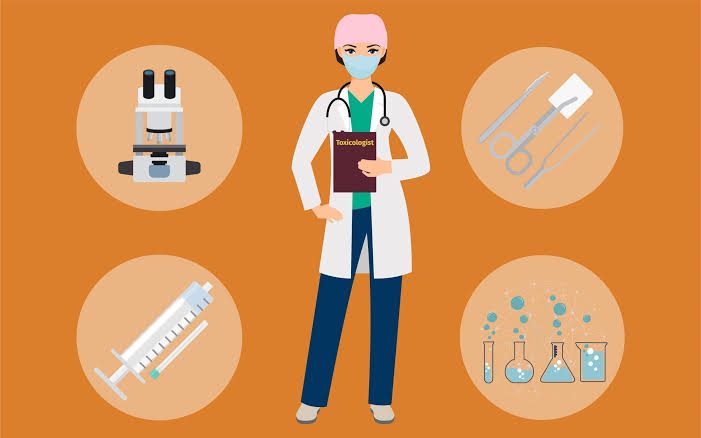Introduction
Forensic medicine is a vital branch of medical science that merges medical expertise with legal principles to aid in the investigation of death, injury, and other medically relevant legal issues. Among its various subfields, forensic toxicology stands out as a critical discipline. Forensic toxicology focuses on the identification and analysis of drugs, poisons, chemicals, and other harmful substances, and their effects on biological systems. This specialization is essential in cases where the presence of toxic substances may have contributed to an individual's death or injury.
One of the most significant areas within forensic toxicology is post-mortem toxicology, which involves the examination of biological samples from a deceased individual to detect the presence of potentially harmful substances. As technology continues to advance, the methodologies used in post-mortem toxicology have evolved, leading to more precise and efficient analyses. These advancements have been instrumental in enhancing the accuracy of toxicological findings, which, in turn, strengthens the overall quality of forensic investigations.
Recent developments in post-mortem toxicology include improvements in mass spectrometry, which allow for the detection of even trace amounts of toxins in biological tissues. These advancements have expanded the range of substances that can be identified and have reduced the time required to generate reliable results. The use of liquid chromatography-tandem mass spectrometry (LC-MS/MS), for instance, has become a gold standard in toxicology testing, providing superior sensitivity and specificity in detecting drugs and poisons in blood, urine, and tissue samples.
Additionally, the integration of new software and automated systems has streamlined the processing and analysis of toxicological data. Automation minimizes human error and increases the speed of processing, allowing forensic toxicologists to provide more timely results. These innovations are particularly significant in criminal investigations, where time is often a critical factor, and the swift identification of toxins can provide crucial evidence that shapes the direction of a case.
The implications of these advancements extend beyond technical efficiency. In criminal investigations, more accurate and timely toxicological findings can lead to a clearer understanding of the cause and manner of death, potentially ruling out or confirming foul play. This enhanced capability supports the legal process by providing robust scientific evidence, which is often a cornerstone in prosecuting or defending individuals in court.
Moreover, as methodologies become more refined, forensic toxicology is also better equipped to handle complex cases, such as those involving poly-drug use or novel psychoactive substances. The evolving landscape of drug abuse, with the rise of synthetic drugs and designer substances, has posed challenges for forensic toxicologists. However, the advancements in technology have enabled the detection of these newer compounds, ensuring that forensic investigations remain up-to-date with emerging trends in substance use.
Forensic medicine is a vital branch of medical science that merges medical expertise with legal principles to aid in the investigation of death, injury, and other medically relevant legal issues. Among its various subfields, forensic toxicology stands out as a critical discipline. Forensic toxicology focuses on the identification and analysis of drugs, poisons, chemicals, and other harmful substances, and their effects on biological systems. This specialization is essential in cases where the presence of toxic substances may have contributed to an individual's death or injury.
One of the most significant areas within forensic toxicology is post-mortem toxicology, which involves the examination of biological samples from a deceased individual to detect the presence of potentially harmful substances. As technology continues to advance, the methodologies used in post-mortem toxicology have evolved, leading to more precise and efficient analyses (Daniel et al., 2022). These advancements have been instrumental in enhancing the accuracy of toxicological findings, which, in turn, strengthens the overall quality of forensic investigations.
Recent developments in post-mortem toxicology include improvements in mass spectrometry, which allow for the detection of even trace amounts of toxins in biological tissues. These advancements have expanded the range of substances that can be identified and have reduced the time required to generate reliable results. The use of liquid chromatography-tandem mass spectrometry (LC-MS/MS), for instance, has become a gold standard in toxicology testing, providing superior sensitivity and specificity in detecting drugs and poisons in blood, urine, and tissue samples.
Additionally, the integration of new software and automated systems has streamlined the processing and analysis of toxicological data. Automation minimizes human error and increases the speed of processing, allowing forensic toxicologists to provide more timely results. These innovations are particularly significant in criminal investigations, where time is often a critical factor, and the swift identification of toxins can provide crucial evidence that shapes the direction of a case.
The implications of these advancements extend beyond technical efficiency. In criminal investigations, more accurate and timely toxicological findings can lead to a clearer understanding of the cause and manner of death, potentially ruling out or confirming foul play. This enhanced capability supports the legal process by providing robust scientific evidence, which is often a cornerstone in prosecuting or defending individuals in court.
Moreover, as methodologies become more refined, forensic toxicology is also better equipped to handle complex cases, such as those involving poly-drug use or novel psychoactive substances. The evolving landscape of drug abuse, with the rise of synthetic drugs and designer substances, has posed challenges for forensic toxicologists. However, the advancements in technology have enabled the detection of these newer compounds, ensuring that forensic investigations remain up-to-date with emerging trends in substance use.
In conclusion, the field of post-mortem toxicology has seen significant advancements in recent years, largely due to improvements in technology and methodologies. These developments have not only increased the accuracy of toxicological analyses but have also made the process more efficient, providing quicker and more reliable results in forensic investigations. As forensic medicine continues to evolve, the role of toxicology in uncovering the truth in criminal cases remains indispensable. The ongoing improvements in this field promise to further enhance the capabilities of forensic investigators, ultimately contributing to a more effective and just legal system.
The Role of Toxicology in Forensic Medicine
Toxicology plays an essential role in forensic medicine by identifying substances that may have contributed to a person's death. It encompasses the detection, identification, and quantification of drugs, alcohol, and other toxins in biological samples. Post-mortem toxicology specifically deals with the analysis of these substances after death, which can provide critical insights into cause and manner of death.
Techniques in Post-Mortem Toxicology
Recent advancements in analytical techniques have significantly enhanced the capabilities of forensic toxicologists. Traditional methods, such as gas chromatography-mass spectrometry (GC-MS) and high-performance liquid chromatography (HPLC), have been complemented by newer techniques, including liquid chromatography-tandem mass spectrometry (LC-MS/MS) and ultra-high-performance liquid chromatography (UHPLC).
LC-MS/MS and UHPLC
Liquid chromatography-tandem mass spectrometry (LC-MS/MS) is a powerful tool for the detection of a wide range of substances at low concentrations. Its sensitivity and specificity make it particularly useful in post-mortem cases where the presence of multiple drugs or substances may complicate the interpretation of results. Similarly, ultra-high-performance liquid chromatography (UHPLC) allows for faster analysis times and better resolution, making it suitable for high-throughput forensic laboratories.
Application of Next-Generation Sequencing (NGS)
Next-generation sequencing (NGS) is revolutionizing forensic toxicology by enabling the analysis of genetic material in conjunction with toxicological data (Khan et al., 2016). This technology can identify genetic predispositions that may influence an individual's response to drugs or toxins, potentially revealing why certain substances were fatal in specific cases. For example, polymorphisms in metabolic enzymes can affect drug metabolism, leading to toxic levels in some individuals.
Case Studies
Case Study 1: Poly-drug Overdose
In a recent case involving a young adult who was found deceased in their home, post-mortem toxicological analysis revealed the presence of multiple substances, including opioids, benzodiazepines, and alcohol. The application of LC-MS/MS allowed toxicologists to identify the concentrations of each substance, establishing that the combined effects contributed to respiratory depression and ultimately death. This case highlights the importance of comprehensive toxicological screening in understanding complex interactions between substances.
Case Study 2: Novel Psychoactive Substances
Another notable case involved a young man who died after ingesting a novel psychoactive substance (NPS). Traditional toxicological tests failed to detect the substance, but advanced screening techniques using UHPLC coupled with high-resolution mass spectrometry identified the NPS in his system. This underscores the growing challenge posed by NPS in forensic investigations, as they often evade detection by standard drug screens.
Implications of Advancements in Toxicology
The advancements in post-mortem toxicology not only enhance the accuracy of death investigations but also inform public health policies. The ability to detect and quantify a wider array of substances allows forensic toxicologists to contribute valuable data to epidemiological studies, helping to track trends in substance abuse and fatalities.
Ethical Considerations
With the integration of advanced technologies in forensic toxicology, ethical considerations regarding consent, privacy, and the potential misuse of genetic information have emerged. It is crucial to establish guidelines that protect individual rights while allowing for the advancement of forensic science.
Conclusion
The field of forensic medicine, particularly post-mortem toxicology, is undergoing significant transformation due to technological advancements. Techniques such as LC-MS/MS, UHPLC, and NGS are enhancing the capabilities of forensic toxicologists, leading to more accurate and comprehensive investigations. As these technologies continue to develop, they will play an increasingly vital role in uncovering the circumstances surrounding deaths and informing public health initiatives. Future research should focus on refining these methodologies and addressing the ethical challenges they present, ensuring that forensic science evolves responsibly and effectively.
References:
- Daniel. I, Abraham. M, Atfrento .T. POSTMORTEM TOXICOLOGY ANALYSIS IN INDIA: RETHINKING THE FUTURE . (2022). Journal of Forensic Medicine & Toxicology,38(2),15–22.Retrievedfrom https://acspublisher.com/journals/index.php/jfmt/article/view/17867.
- Khan, Iram & Shakeel, Mohammad & Sharma, G.. (2016). Viscera preservation for post mortem toxicological analysis: A Review. Journal of Indian Academy of Forensic Medicine. 38. 241. 10.5958/0974-0848.2016.00061.0.

